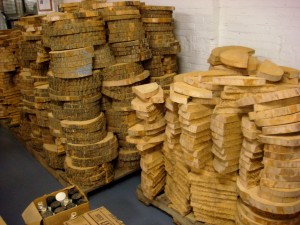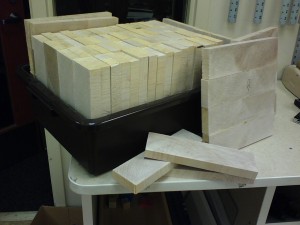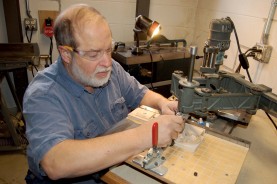Maple Logs to Type, A Modern Version (1)
One of the first things you notice about larger wood type is that there are no glue joints. Whether it is a 4-line upper case A or a 30 line lowercase g, historic wood type will have no glue joints. With the improvements in adhesive technology in the last 100 years, we are now very accepting of glued up butcher-block counter tops, and glue joints in tabletops and door molding.
If you are lucky enough to visit the Hamilton Wood Type & Printing Museum, in Two Rivers, Wisconsin, you will see pallets and pallets, and shelves and shelves full of 1/2 log slabs of end-grain sugar maple that have been drying for a very long time. This is the wood stock that type would have been cut from. If you are there at the right time, you will also see a craftsman cutting the maple ½ slabs into line size strips and then cutting them into letters on one of the three Pantographs.
Wisconsin was a perfect location for a type and furniture factory with huge tracks of old growth maple for type and oak for cabinets and furniture. Unfortunately, even though they have the original large surface sanding and the type-high machines on display, right down to the bison hide belts common to the Industrial Revolution period, they are not running. Hamilton is currently still cutting type from their supply of maple from the 1960s.
Anyone making wood type today is limited to the size of the block of type high maple you can purchase from many vendors supplying the engraving and art industries. These blocks are very expensive, often are not really type high, and to avoid warping and checking, glued up from many little pieces using a modern industrial adhesive. Glue joints again!
At Moore Wood Type, I have been making a trip to Amish country in North East Ohio to get the maple stock to cut type from and also from Wood Werks. Wood Werks stocks four/quarter (3/4 inch thick), five/quarter (1 inch thick) and eight/quarter (1/3/4 inch thick) hard and soft kiln dried maple. You lose ¼ inch to the planer when the rough boards are surfaced. The soft maple is actually red maple and the hard maple, or white maple, is sugar maple. Although many craftsman say they use “Hard Rock Maple,” according to several local saw mill operators and my maple supplier, hard rock maple is harder to find, but is still considered sugar maple. One older saw mill owner told me his grandfather taught him that “The hard rock maple is easy to find because it is the first maple to lose it’s leaves in the Fall.”
The Amish Lumber yards stock hard maple boards 12/4 (2 3/4 inch thick) in 10-foot lengths and anywhere from 6 to 12 inches wide. The maple stock I am currently cutting from is from both locations. This limits the widest or longest size I can cut without a glue joint to 3” x 12”.
Steve Willis and his family, from Willis Lumber Co. in Washington Courthouse, has been supplying the hard and softwood needs of schools and craftsmen for over 123 years. I asked him on a research road trip, why I could not find any kiln dried maple boards thicker than 3 inches? He explained that the kiln drying process for maple above that thickness takes the “life” or density out of the wood. It works for furniture, and large moldings, but would not hold up to the pressure of a letterpress for very long.
On a sad note, Willis Lumber Co. closed in January of 2011. This is a loss for all the woodworkers in the Mid-West.
Moore Wood Type follows the rule they have always had for making large size type, above 5 or 6 inches from edge grain due to the cost and stability of end-grain wood at that size. When my daughter, Erin, needed a 72 line (12”) dollar sign for one of her posters, I cut it from a large piece of face grain maple, sanded to type high and sealed with shellac.
I decided to solve the “no glue joint” problem by cutting my own large maple ½ slabs, and slowly drying them in the historic process. (Continued)





